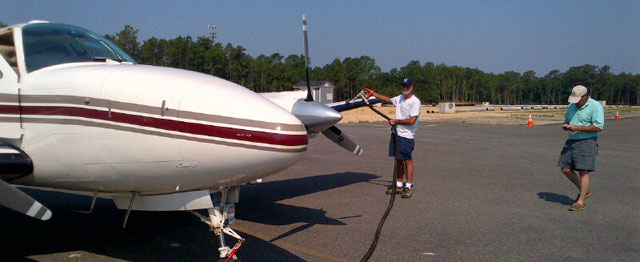
Peter Weidhorn, who has invested millions of his own money building a sleepy airstrip into a general aviation destination, tops off the tanks from a newly-installed fuel farm at Eagles Nest Airport (31E). Photo courtesy Peter Weidhorn.
Concrete is being poured for hangars; a fuel tank now offers self-serve avgas from Phillips 66 where none was available before. Lights are on the way, and owner Peter Weidhorn has big dreams for what was until recently just a 3,200-foot runway and little else, the only landing strip for miles around on the southern coast of New Jersey.
“For the last 40 years it’s just been a little sleepy field,” said Weidhorn, an AOPA President’s Council member and the prime benefactor of the only public-use field between Atlantic City and Toms River. Weidhorn has staked more than $3 million of his own money on expanding Eagles Nest into a full-service general aviation destination, bringing electrical and other utilities in where none existed before. “It’s my pleasure: It’s my passion.”
New Jersey Transportation Commissioner James Simpson is well acquainted with Weidhorn’s effort, himself a longtime GA pilot and life member of AOPA. Simpson said the state has invested $1.15 million to rebuild the runway and install lights in recent years, funding that has been doled out more carefully under his administration.
Preservation of the state’s 44 general-use airports is a state priority, Simpson said, adding that in that respect the administration of Gov. Chris Christie is very much in step with AOPA.
“Peter is the kind of guy that you really want to have,” Simpson said. “It takes that kind of private investment today. It’s great to see.”
Weidhorn said he is counting on Simpson to continue the state’s support of his effort—particularly with construction of a taxiway. He hopes to attract an FBO, a maintenance operation, and a flight school. He has adjacent land earmarked for hangar homes, but much will depend on the support of both government and the flying public.
There are promising signs—several of the new hangars being built in coming weeks are already rented—and more at stake than infrastructure. Long active in education and philanthropy, Weidhorn said aviation has great power to separate a generation of children from their portable electronics and get them dreaming.
There are “so many opportunities for jobs and so many opportunities to learn and be stimulated through flying,” Weidhorn said.
Weidhorn is working with regional EAA chapters to create more of those opportunities. He has already hosted a pair of open house events, inviting local residents to come and get to know what an airport can offer. Even with no signage and a fledgling website, Weidhorn has fielded a dozen or more inquiries about flight training.
“It’s amazing how many people have called me for flight training,” Weidhorn said.
Weidhorn said an important lesson has come of his effort to date: Airports must be saved at all costs. Even with the benefit of pre-existing use, the task of securing local approvals has been cumbersome, to say the least, and it is impossible to imagine undertaking such an effort from scratch.
“When we lose existing airports we lose the franchise,” Weidhorn said. He has high hopes his effort and investment will pay off in the form of new pilots, a fleet of based aircraft, and a vibrant community of aviators and learners. “With any luck, we’re going to do fine.”



